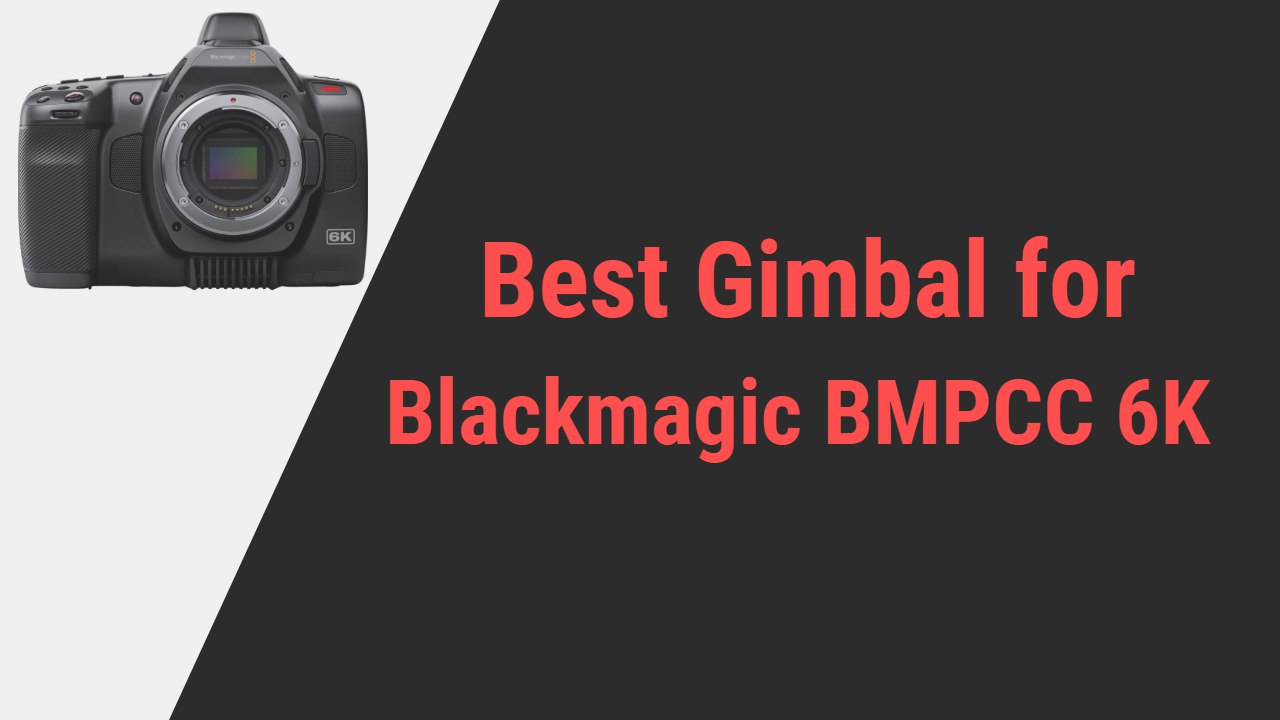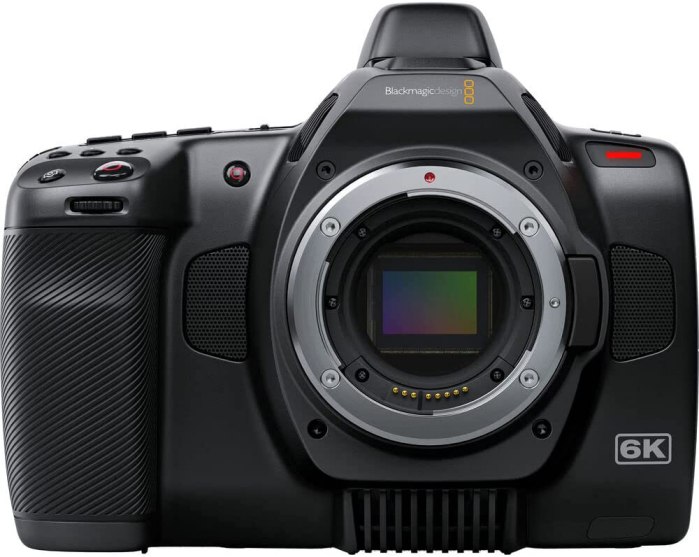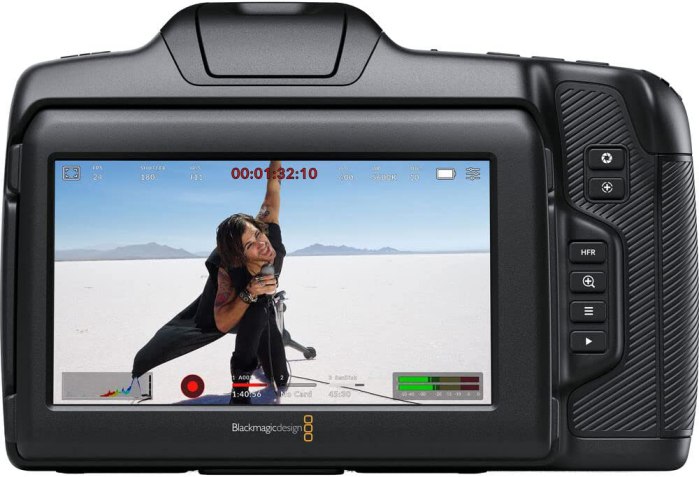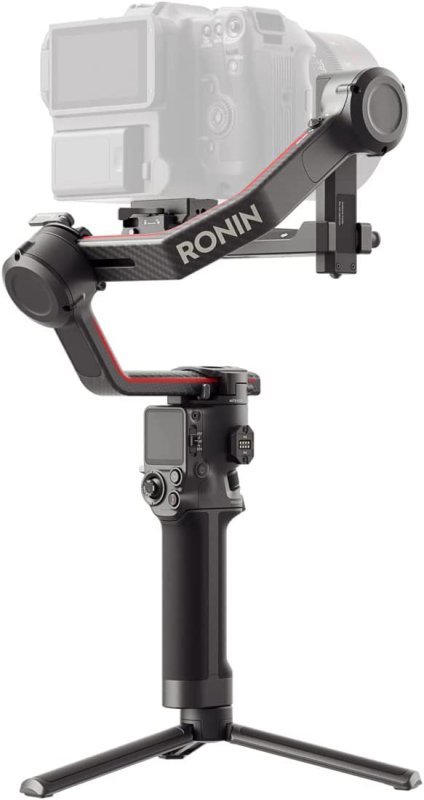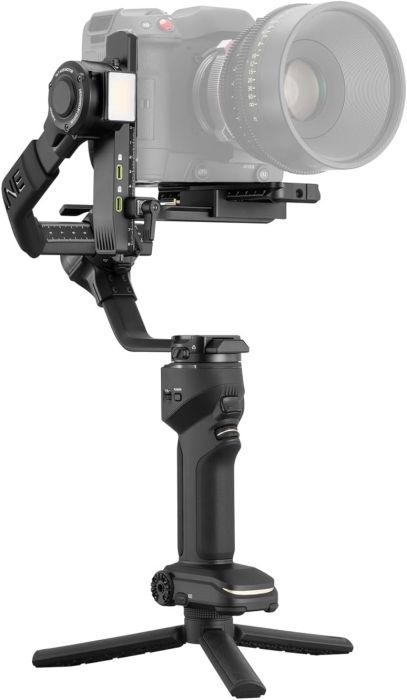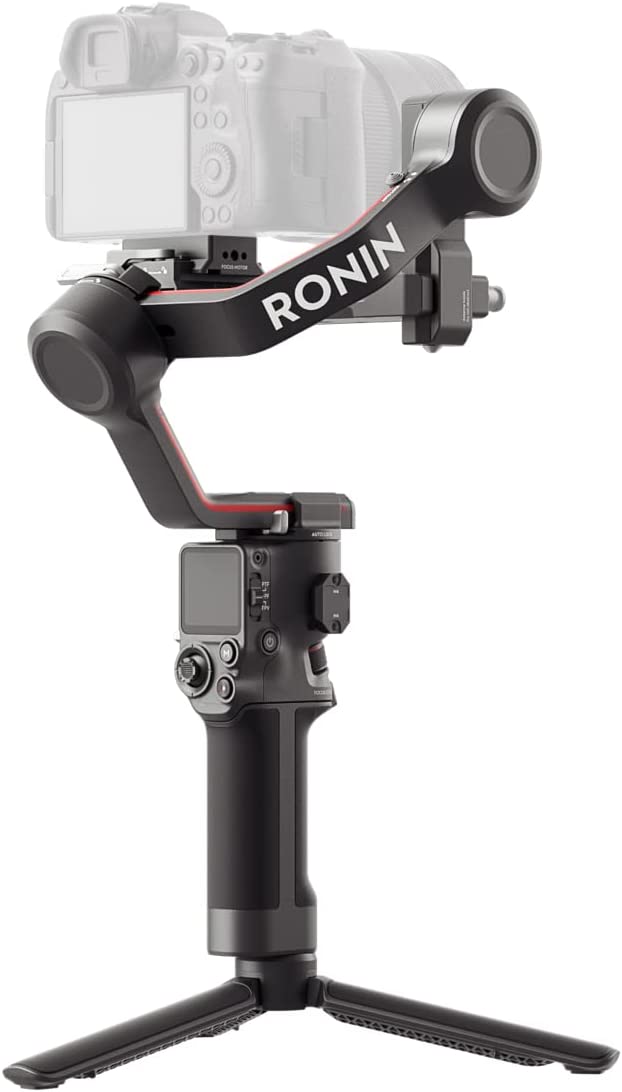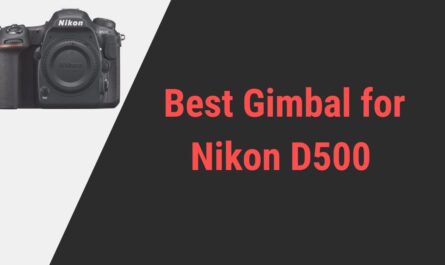In the realm of filmmaking, the Blackmagic Pocket Cinema Camera 6K (BMPCC 6K) stands as a beacon of cinematic prowess, renowned for its ability to capture high-resolution cinematic footage.
However, to fully unleash its potential, a reliable gimbal becomes an indispensable tool. The quest for the perfect stabilizing companion tailored for the BMPCC 6K is paramount for filmmakers and content creators seeking seamless, stabilized shots.
From compact designs to cutting-edge stabilization technology, this exploration aims to uncover the ideal gimbal that complements the BMPCC 6K, empowering filmmakers to capture smooth, professional-grade footage and elevate their storytelling to new cinematic heights.
Blackmagic BMPCC 6K
Note:
All the gimbals mentioned here are tested with BMPCC 6K and work perfectly fine.
| DJI RS 3 Pro (Best of the Best)

|
| Zhiyun Crane 4
   |
We are sure that you might know the camera, but let us get to know you a bit more so you can make an accurate choice about which gimbal you should get.
About BMPCC 6K Camera
The Blackmagic Pocket Cinema Camera 6K (BMPCC 6K) is a powerhouse in the world of filmmaking, boasting exceptional capabilities that cater to both professionals and enthusiasts.
This compact yet robust camera combines impressive imaging capabilities with user-friendly functionality, making it a standout choice in the market. At the heart of the BMPCC 6K lies its 6K Super 35 sensor, delivering stunningly detailed and cinematic footage.
With a 6144 x 3456 pixels resolution, this sensor allows filmmakers to capture incredibly sharp and vibrant images with exceptional clarity. Coupled with 13 stops of dynamic range, this camera excels in preserving details in both shadows and highlights, offering a wide latitude for creative post-production work.
One of the BMPCC 6K’s defining features is its ability to shoot in Blackmagic RAW, a format that retains maximum image quality and flexibility in post-production.
This format provides ample room for color grading and manipulation, empowering filmmakers to achieve their desired visual aesthetics effortlessly.
Equipped with EF lens mount compatibility, the BMPCC 6K offers versatility in lens selection, allowing users to leverage a wide array of Canon EF lenses to suit their shooting needs.
Additionally, the camera supports various recording formats and frame rates, including 6K at up to 50fps and 4K DCI at up to 60fps, providing flexibility in capturing different styles and motions.
In terms of usability, the camera features a 5-inch touchscreen display that offers intuitive navigation through settings and menus. This interface simplifies the adjustment of camera parameters, making it accessible for users transitioning from still photography to the realm of filmmaking.
Despite its compact size, the BMPCC 6K doesn’t compromise on connectivity options. It includes a full-size HDMI port for external monitoring or recording, a mini XLR input for professional-grade audio, and a USB-C port for high-speed data transfer and battery charging.
Overall, the Blackmagic Pocket Cinema Camera 6K stands as a testament to innovation in the world of filmmaking. Its exceptional image quality, robust features, and flexibility in post-production make it an appealing choice for filmmakers seeking cinematic excellence in a compact and accessible package.
Whether used in independent filmmaking, documentaries, or commercial productions, the BMPCC 6K continues to impress with its powerful performance and versatile capabilities.
Specifications of BMPCC 6K
- Sensor – Super 35mm (23.10mm x 12.99mm) 6K resolution (6144 x 3456)
- Dynamic Range – 13 stops
- Lens Mount – Canon EF
- Recording Formats – Blackmagic RAW and ProRes
- Frame Rates –
- 6K at up to 50fps
- 5.7K at up to 60fps
- 4K DCI at up to 60fps
- 3.7K at up to 80fps
- 1080p at up to 120fps
- ISO Range – Dual Native ISO of 400 and 3200
- Media – CFast 2.0, SD/UHS-II cards
- Display – 5-inch touchscreen LCD (1920 x 1080)
- Audio – Mini XLR input, 3.5mm headphone jack, and stereo speakers
- Connectivity – Full-size HDMI output, USB-C expansion port, LANC remote control, and mini XLR input
- Power – Uses Canon LP-E6 batteries or DC power via a 12V power input
- Dimensions – 7 x 3.8 x 3.4 inches (178.1 x 96.8 x 84.5mm)
- Weight – Approximately 1.98 lbs (890g) without lens or battery
- Supported Resolutions –
- 6144 x 3456 (6K)
- 6144 x 2560 (6K 2.4-1)
- 5744 x 3024 (5.7K 17-9)
- 4096 x 2160 (4K DCI)
- 1920 x 1080 (1080p Full HD)
These specifications outline the BMPCC 6K’s features, including its sensor size, resolution, recording capabilities, connectivity options, and supported resolutions, all formatted with dashes for improved readability.
Now, it’s time we take you towards the best gimbals for this amazing camera. We have tried and tested these gimbals, so when it comes to a purchase decision, you just have to make sure what is your criteria and which gimbal matches your criteria the most.
Best Gimbal for BMPCC 6K
1. DJI RS 3
The DJI RS 3 stands out as a top-tier gimbal, offering exceptional stabilization and versatile features, making it an ideal companion for the Blackmagic Pocket Cinema Camera 6K (BMPCC 6K).
This gimbal’s prowess lies in its ability to provide steady, fluid motion shots while catering to the specific needs of filmmakers using the BMPCC 6K. The DJI RS 3’s compatibility with the BMPCC 6K is exemplary.
Its payload capacity of up to 4.5 kilograms (10 pounds) comfortably supports the BMPCC 6K and various accompanying accessories, ensuring smooth stabilization even with a moderately heavy setup.
The gimbal’s adaptability to different camera configurations allows filmmakers to explore diverse shooting styles without compromising stability.
The RS 3 boasts a highly intuitive and customizable control system. Its ergonomic design and grip provide a comfortable and secure hold during extended shooting sessions.
The intuitive joystick and multifunctional dial offer precise control over pan, tilt, and roll movements, facilitating seamless adjustments for capturing dynamic footage.
Furthermore, the RS 3’s intelligent features elevate the filmmaking experience. The ActiveTrack 3.0 technology enables the gimbal to automatically track subjects, ensuring they remain in focus, making it an excellent choice for filmmakers capturing moving scenes or dynamic shots.
Additionally, the DJI RavenEye Image Transmission System provides real-time monitoring, enabling filmmakers to preview shots on a mobile device, enhancing precision and creativity in framing shots.
A standout feature of the RS 3 is its versatile shooting modes tailored to cinematographic needs. The gimbal offers a variety of modes, including panorama, time-lapse, and Inception Mode, which allows for stunning, creative, and dynamic camera movements.
This versatility empowers filmmakers to explore various visual storytelling techniques and capture captivating footage with ease. Moreover, the RS 3’s battery life is commendable.
With a runtime of up to 12 hours on a single charge, this gimbal ensures prolonged shooting sessions without interruption. Its fast-charging capability also minimizes downtime, allowing for quick replenishment between shoots.
Specifications of DJI RS 3
- Payload Capacity – Up to 4.5 kilograms (10 pounds)
- Battery Life – Up to 12 hours runtime
- Compatibility – Supports BMPCC 6K and other compatible cameras
- Control – Intuitive joystick and multifunctional dial
- Technology – ActiveTrack 3.0 for automatic subject tracking
- Image Transmission – DJI RavenEye Image Transmission System
- Shooting Modes – Panorama, time-lapse, and Inception Mode
- Charging – Fast-charging capability
- Ergonomics – Ergonomic design for comfortable handling
Pros
- Excellent payload capacity
- Long-lasting battery life
- Versatile shooting modes
- Intuitive controls and ergonomic design
- ActiveTrack 3.0 technology
- DJI RavenEye Image Transmission System f
Cons
- Initial setup might be challenging for larger cameras.
- Caution advised near maximum payload for optimal performance.
2. Zhiyun Crane 4
The Zhiyun Crane 4 stands as a versatile and reliable gimbal, designed to meet the needs of filmmakers seeking smooth stabilization and creative control over their shots.
With its array of features and user-friendly design, the Crane 4 caters to both enthusiasts and professionals, offering impressive performance for various filming scenarios.
At its core, the Crane 4 excels in its stabilization capabilities. With a payload capacity of up to 4 kilograms (8.8 pounds), it accommodates a wide range of mirrorless and DSLR cameras, including models like the BMPCC 6K, ensuring stable footage even with heavier setups.
This capacity makes it an ideal choice for diverse shooting needs, from cinematic storytelling to documentary-style filming.
The gimbal’s intuitive controls are a standout feature. The joystick and control dial offers precise manipulation of pan, tilt, and roll movements, granting filmmakers the flexibility to adjust angles and capture dynamic shots effortlessly.
Additionally, the Crane 4 features a revamped axis locking system, simplifying balancing and setup for quick and efficient use. Zhiyun’s innovation extends to the Crane 4’s intelligent features.
The gimbal integrates advanced modes such as MotionMemory and Object Tracking, allowing users to create complex camera movements or track subjects with ease.
MotionMemory enables pre-set movement paths for the camera, while Object Tracking ensures the camera follows designated subjects, enhancing the overall filming experience.
Furthermore, the Crane 4’s battery life is commendable. With up to 12 hours of runtime on a single charge, filmmakers can indulge in extended shooting sessions without interruption.
Additionally, the gimbal’s quick-charge functionality reduces downtime, ensuring minimal waiting between shoots. Despite its strengths, there are considerations when using the Crane 4.
While the gimbal offers remarkable stabilization, heavier camera setups might slightly strain the motors and impact battery life. Users should ensure they stay within the recommended payload capacity for optimal performance.
Specifications of Zhiyun Crane 4
- Payload Capacity – Up to 4 kilograms (8.8 pounds)
- Battery Life – Up to 12 hours runtime
- Compatibility – Supports various mirrorless and DSLR cameras
- Controls – Joystick and control dial for precise manipulation
- Axis Locking System – Revamped system for simplified balancing and setup
- Intelligent Modes – MotionMemory and Object Tracking for versatile shooting
- Quick Charge – Reduces downtime between shooting sessions
Pros
- High payload capacity
- Long battery life
- Motion Memory feature
- Object Tracking feature
- Intuitive controls and revamped axis locking system
Cons
- Heavier camera setups might strain motors
Comparing DJI RS 3 and Zhiyun Crane 4
Choosing the best gimbal for the Blackmagic Pocket Cinema Camera 6K involves considering various factors such as payload capacity, stabilization, intelligent features, battery life, and compatibility. Two popular options, the DJI RS 3 and Zhiyun Crane 4, stand out in the market and offer distinct features suited for different filmmaker needs when paired with the BMPCC 6K.
Payload Capacity
The BMPCC 6K isn’t the lightest camera, so a gimbal with a decent payload capacity is essential. The DJI RS 3 offers a robust 4.5kg (10 lbs) payload, while the Zhiyun Crane 4 supports up to 4kg (8.8 lbs). Both gimbals handle the BMPCC 6K comfortably, accommodating additional accessories if necessary.
Stabilization
Stability is crucial for smooth and professional-looking footage. Both gimbals excel in this aspect. The DJI RS 3 utilizes advanced stabilization technology, ensuring steady shots even in dynamic filming situations. Similarly, the Zhiyun Crane 4 boasts reliable stabilization, reducing shake and ensuring a fluid shooting experience.
Intelligent Features
Filmmakers often seek intelligent features for enhanced creativity and convenience. The DJI RS 3 introduces ActiveTrack 3.0 for automatic subject tracking, enabling smooth focus on moving subjects. On the other hand, the Zhiyun Crane 4 offers MotionMemory and Object Tracking modes, allowing pre-set movement paths and tracking designated subjects for diverse shooting styles.
Battery Life
Extended battery life ensures uninterrupted filming sessions. The DJI RS 3 impresses with up to 12 hours of runtime, ideal for long shots without worrying about frequent recharging. Similarly, the Zhiyun Crane 4 offers the same extensive battery life, providing filmmakers with extended filming sessions.
Compatibility and Controls
Compatibility and ease of use are pivotal. The DJI RS 3 supports various camera models, including the BMPCC 6K, offering intuitive controls and a user-friendly design. Conversely, the Zhiyun Crane 4 ensures seamless compatibility and provides revamped controls, making adjustments and filming more efficient.
Considerations
While both gimbals excel in various aspects, some considerations exist. The DJI RS 3 might be slightly more user-friendly with its control interface, but the initial setup could be challenging for larger camera setups like the BMPCC 6K. Similarly, the Zhiyun Crane 4, despite its strong performance, may experience strain when near its payload limit, affecting performance.
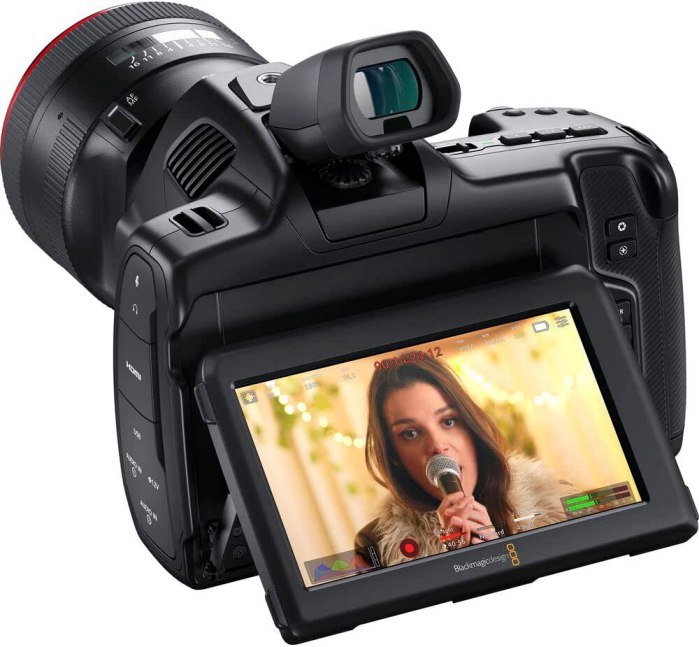

Tips on choosing the correct gimbal
Choosing the right gimbal can significantly impact your filming experience. Here are ten tips to consider when selecting the correct gimbal,
- Ensure the gimbal can support your camera’s weight. Check its payload capacity to prevent strain on the motors.
- Look for gimbals with excellent stabilization features to ensure smooth, shake-free footage, especially for dynamic shots.
- Verify compatibility with your camera model. Not all gimbals are suitable for every camera, so ensure a perfect fit.
- Consider gimbals with long battery life to accommodate extended filming sessions without frequent recharging.
- Evaluate intelligent features like automatic subject tracking, time-lapse, or motion modes that elevate your creativity and filming options.
- Assess the gimbal’s weight and size for ease of transportation and maneuverability during shoots.
- Look for user-friendly controls and interfaces to ensure quick adjustments and smooth filming experiences.
- Seek gimbals offering multiple shooting modes and configurations to adapt to various filming scenarios.
- Research and read user reviews or seek recommendations from experienced filmmakers to gauge real-world performance and reliability.
- Set a realistic budget and find a gimbal that balances cost and features, aligning with your filming needs.
Final thoughts
Choosing between the DJI RS 3 and Zhiyun Crane 4 for the BMPCC 6K boils down to individual preferences and specific filming requirements. Filmmakers prioritizing extended battery life and advanced subject tracking might lean towards the DJI RS 3.
Conversely, those valuing a more user-friendly interface and versatile shooting modes might favor the Zhiyun Crane 4. In summary, both gimbals offer commendable features, ensuring stable footage for the BMPCC 6K.
Understanding individual needs and assessing the significance of features like payload capacity, stabilization, intelligent modes, battery life, and user interface will assist in selecting the ideal gimbal for seamless filming experiences with the Blackmagic Pocket Cinema Camera 6K.

